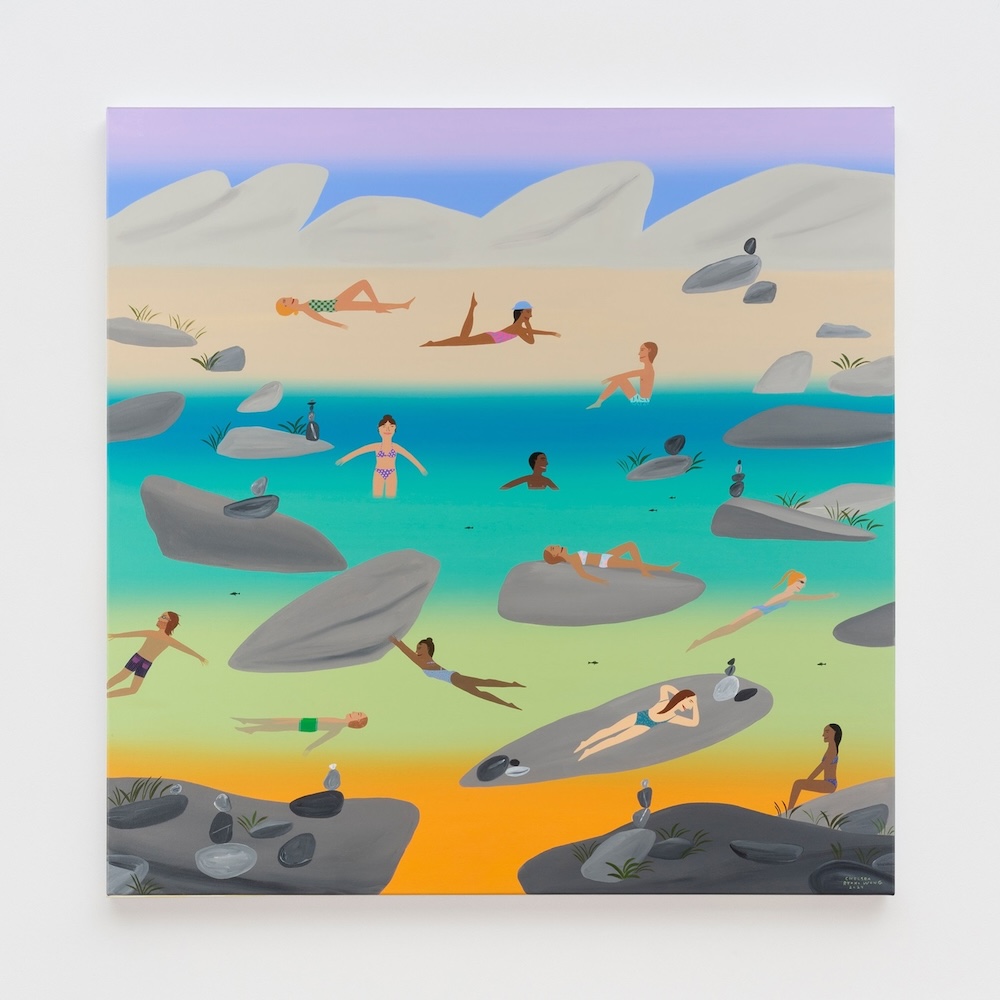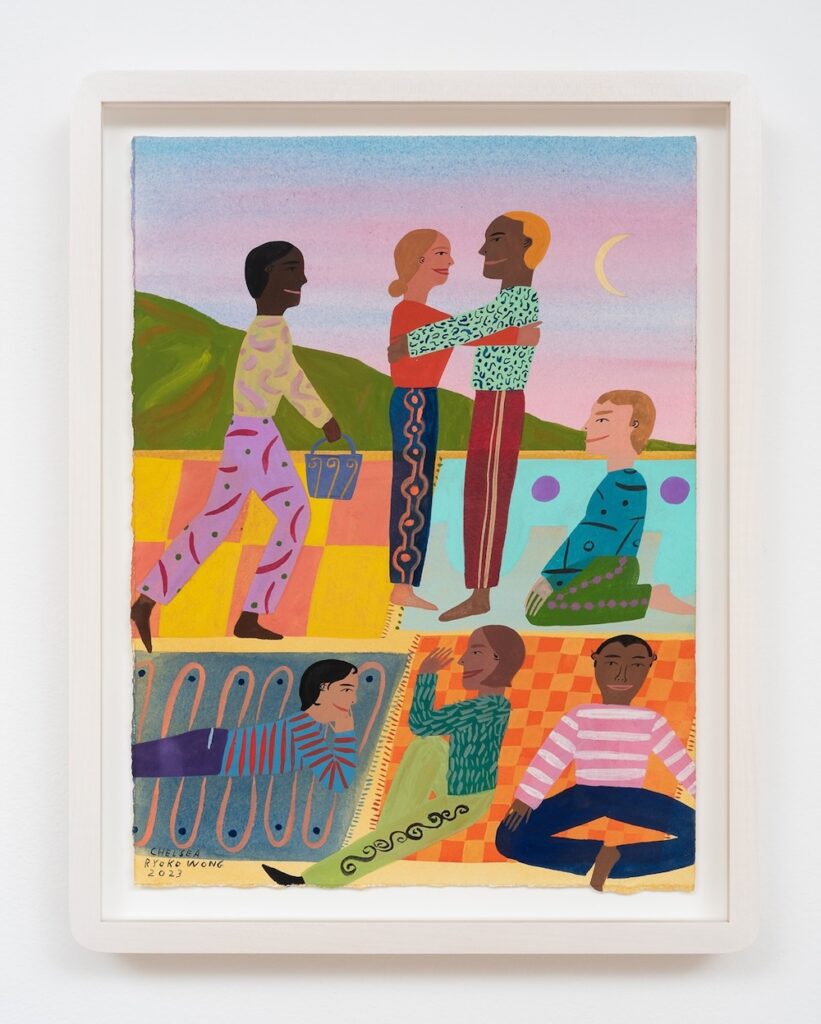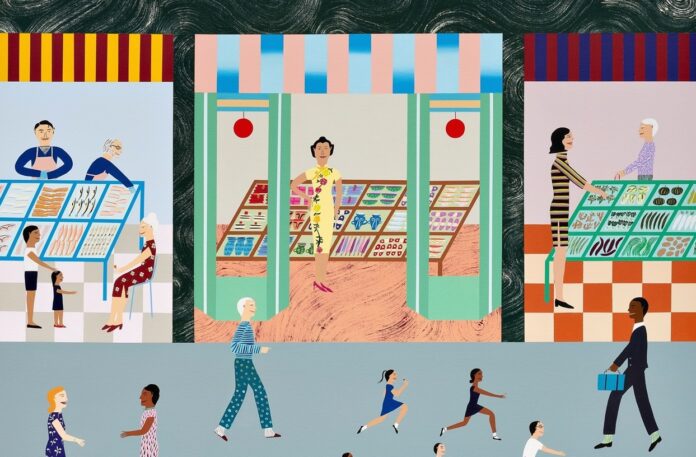Playful and honest works fill the San Francisco studio of artist Chelsea Ryoko Wong. Creating primarily in acrylics on canvas, her paintings are whimsical and vibrant, inhabiting space with a stylized, narrative brightness. Recognizing cultural diversity within everyday lives, Wong tells stories in a contemporary vernacular.
Though she’s now known for her murals, for a long time, Wong was nervous to make big paintings. It didn’t make sense logistically—she was working in a very small studio and painting with watercolors. But challenging herself to learn a new medium and change the scale in which she worked opened new doors, manifesting into her current career as a full-time artist.

“I always say I learn new things every day, so each time I walk into the studio, it’s an opportunity for me to push myself and continue growing into the artist I want to become. Some days I’m there and other times I’m not. That is why art is called a practice,” Wong told 48hills.
Wong was born and raised in Seattle and studied integrated design curriculum at Parsons from 2004 to 2005. She moved to San Francisco in 2007 to attend California College of the Arts, where she received a BFA in printmaking in 2010. Wong has lived and worked in the Mission District since her move to San Francisco and says the Bay Area art community’s unique and supportive vibe excites her.
“Because it has always been a place for free-spirited thinking and inclusion, the art scene here makes room for all types of art, careers, personalities, and paths forward. The Bay Area Figurative Movement established this area as a region for figurative painting, which helped pave the way for this genre to move forward. From art handlers, to dealers, curators, collectors, and artists, there seems to be a positive mindset around working together,” Wong said.
Wong’s creative spark derives in large part from an intuitive sense of her place in the world. She says that traveling, growing up in a diverse family—in particular, the experience of being Asian American—philosophy and Buddhism, good food, and an attention to history all feed her life and work. Cultivating gratitude and awe are also important inclinations for the artist, adding that being aware of her surroundings and experiencing “the grandeur and particular natural beauty of California” are essential. For example, in creating the painting, In Tandem (2024), Wong says she aimed to represent the atmosphere and sunset of the Bay Area.

“For me, this painting is rooted in our landscape, the feeling of being above the clouds, watching hobbyists, and groups of people enjoy nature,” she said.
With regard to specific art movements that have inspired her, Wong cites The Mission School and the Impressionists as vital. Ukioy-e, a style of pictorial woodblock printing and painting from the Tokugawa period of Japan (1603–1867), is another influence. It’s interesting to note that the genre’s name translates to “pictures of the floating world,” effectively what Wong is aiming for in her work.
“I am interested in humanity, how we experience the world, what connects us and how we navigate through life. I studied printmaking in college but paint in acrylic and watercolor now. I still approach the canvas like a printmaker, working in flat layers to build up a scene,” Wong said.
For the painting Chasing Dreams, Wong wanted to capture the atmosphere of Grant Avenue in San Francisco’s Chinatown; its shops, colorful tiles, marbled walls, and inter-generational family life.
“In this painting, class just got out and school children are chasing a ball, asking an elder for candy in a shop, and just being kids. There is a sense of community and it captures the hum of Chinatown through a shopkeeper’s lens. Because this is part of my residency and exhibition at the Oakland Museum of California, I incorporated dresses from their collection, connecting the past to the present,” Wong said.
Wong adds that the work for the current show, which runs through February 1, 2026, is part of a one-year artist-in-residency program through the Harker Fund. The exhibition explores OMCA’s collection of Chinese dresses and reimagines the lives of the women who donated them through a modern perspective. The installation ponders fashion, history, and the role of clothing as it relates to identity.

In her light-filled studio in the Mission, a space with high ceilings and concrete floors spattered with paint that reveal a long history, Wong gets to work. She calls the space “small yet mighty” with an interior that is cold, even on the hottest day. A typical artmaking session for her begins around 11am with coffee and emails, then segues into painting in the afternoon. Wong generally doesn’t plan out her paintings in advance, but sketches through ideas as she goes.
“In the evening (or as soon as it gets dark outside) is when my creative brain really turns on and the serious work begins. Sometimes I paint late into the night, which is nice and quiet and it’s easier to concentrate. I like working on one painting at a time, which is how I stay organized with the colors I use. Each shape has multiple layers and I have an organization system with lots of paints in to-go containers. I generally start with the background and move forward, letting the painting unfold and speak to me. A painting usually feels finished when it feels just busy enough,” she said.
Since childhood, Wong has enjoyed making art and being creative. She says that creating things with her hands always brought a lot of satisfaction, and she knew she would make things regardless of what career she pursued. An initial bump in the road of her studies inadvertently helped develop her distinct style, ultimately guiding her in the right direction.
“When I was in art school at Parsons, they really pushed me to paint realistically, which I did not enjoy. It felt like a contest I had no interest in, nor did I want to enter. As an Asian American woman, painting in a male dominated European aesthetic does not appeal to me,” Wong said.
One of the first pivotal moments for the artist was learning about the Mission School and seeing how creative artists in that movement were using a bold, graphic style. She says it freed her to grow into the artist she wanted to become. The second turning point was the decision to change to acrylics and increase the size of her canvases. Her subject matter has remained consistent, however, and Wong has been making art that focuses on empowerment, joy, and diversity for a long time.

“During the last few years, we’ve experienced and witnessed multiple social, political, and environmental upheavals, which has encouraged me to continue creating the work that I do. I think it’s important, now more than ever, for artists to continue creating work that keeps us questioning, feeling grounded, feeling empathy, or whatever the message is that you want to spread with your art,” Wong said.
Wong’s recent solo exhibitions include Nostalgia for the Present Tense at Jessica Silverman in San Francisco, her primary gallery representative, and Community Feast, which is currently showing at the Asian Art Museum. She was also included in the group show About Place: Bay Area Artists from the Svane Gift at the de Young Museum.
In addition, Wong has created colorful murals for interior and exterior spaces, including a wall inside La Cocina’s Municipal Marketplace in the Tenderloin, a mural for the Facebook AIR Program, and restaurants Hon’s Wun Tun Noodle House and Little Jane on Grant, which are both located in San Francisco’s Chinatown neighborhood.
Artist Chelsea Wong encourages the Bay Area to stay involved through art, art openings, supporting the arts, and creating art, saying that she believes that our creative community is only as strong as we make it. Through her personal offerings of colorful, expressive paintings, and murals, Wong wants viewers to experience one thing:
“I hope people take a moment to remind themselves that life can be very sweet.”
For more information, visit her website at chelseawong.com and on Instagram. All images are courtesy of the artist and Jessica Silverman.





